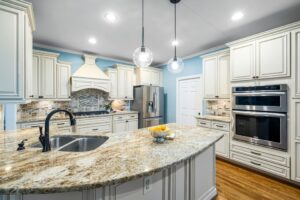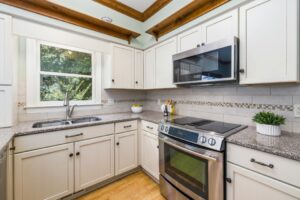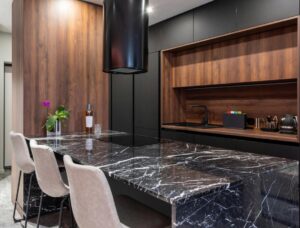Planning Your Kitchen Remodel
Setting a Budget
It’s essential to decide how much you are willing to spend on your kitchen remodel. Include costs for appliances, materials, and potential professional help. Planning a realistic budget helps prevent overspending and ensures that all necessary components of the remodel are covered.
Determining Your Kitchen Needs
Identify what changes are necessary in your current kitchen. This might include more counter space, a larger stove or refrigerator, or extra storage. Understanding your specific needs ensures that the remodel will enhance the functionality of your kitchen.
Creating a Remodel Timeline
Make an estimate of how long each part of the remodel will take. Factor in time for unexpected problems or delays. A detailed timeline helps keep the project on track and reduces the chances of prolonged disruption to your daily routine.
Designing Your New Kitchen
Choosing a Layout
The layout should improve functionality and suit the style of your home. Consider foot traffic patterns and the locations of different zones like the cooking area and dining space. Common layouts include U-shaped, L-shaped, and galley kitchens, each offering unique benefits.
Selecting a Color Scheme
Pick colors that reflect your taste but also create a welcoming environment. Lighter shades can make small kitchens feel bigger, while dark hues give large spaces warmth. Harmonizing colors with the rest of your home ensures a cohesive design.
Picking Materials for Countertops, Cabinets, and Floors
Choose durable materials that can withstand heavy use without sacrificing aesthetic appeal, such as granite countertops or hardwood floors. Ensure that the materials selected align with your budget and maintenance preferences.
Preparing for the Remodel
Clearing out the Kitchen
Before starting work, remove all items from cabinets and shelves. This step protects your belongings from dust and damage and makes the workspace accessible for contractors.
Setting up a Temporary Kitchen
Set up an alternative place where you can prepare meals during the construction process. This temporary setup can include a microwave, toaster oven, and a small fridge to maintain functionality during the remodel.
Protecting Other Areas of Your Home
Cover doors with plastic sheets to prevent dust from spreading into other rooms. This containment helps keep the rest of your home clean and minimizes the cleanup effort post-remodel.
Doing the Remodel
Removing Old Fixtures and Appliances
Start by taking out old fixtures such as sinks or stoves carefully, not causing any damage. This careful removal allows for potential reuse or donation of old items.
Installing New Cabinets and Countertops
After removing the old ones, install new cabinets based on the layout plan, followed by countertop installation. Proper installation ensures stability and longevity of these essential components.
Laying New Flooring
Once the above installations are done, proceed with flooring using the material chosen earlier. This sequence helps prevent damage to new floors during cabinet and countertop installation.
Painting Walls and Installing Backsplash
Post installing the floor, paint walls as per the chosen color scheme and add a backsplash to protect them. These finishing touches enhance the kitchen’s aesthetic appeal and protect walls from spills.
Installing New Appliances
Install new appliances like the refrigerator, oven, or dishwasher post painting. Ensure appliances are correctly fitted and functioning before considering the remodel complete.
Finishing Touches
Cleaning up after the Remodel
After the remodel work, clean the entire kitchen area, removing any debris. A thorough cleaning ensures your new kitchen is ready for use and looks its best.
Organizing your New Kitchen
Organize items in cabinets, ensuring frequently used ones are easy to access. Efficient organization enhances functionality and makes the kitchen more enjoyable to use.
Adding Decorative Elements
Add personal touches like decorative lights or plants for a homely feel. These elements reflect your personality and make the kitchen a welcoming space.
Tips for a Successful Kitchen Remodel
Staying Patient and Flexible
Patience is key during a remodel. Unforeseen delays can occur, so stay flexible with the timeline. Maintaining a positive attitude helps manage stress and keeps the project enjoyable.
Keeping Safety in Mind
Take precautions while handling heavy objects and electrical installations. Ensuring safety reduces the risk of accidents and promotes a smooth remodeling process.
Seeking Professional Help When Needed
For complex tasks like gas installation, it’s better to seek professional help. Expert assistance ensures that installations are safe and comply with regulations.
Common Mistakes to Avoid
Overspending
Avoid going over budget by keeping track of all expenses diligently. Sticking to your budget prevents financial strain and ensures the project remains affordable.
Neglecting Storage Space
Ensure you have enough storage space according to your needs. Ample storage keeps the kitchen organized and clutter-free, enhancing its functionality.
Choosing Style Over Function
Aesthetics should not compromise the functionality of the kitchen. Balancing style with practicality ensures the remodel meets your daily needs.
Benefits of a DIY Kitchen Remodel
- Saving Money: DIY saves money spent on labor costs.
- Customizing to Your Personal Taste: You get the freedom to design as per your taste without depending on someone else’s vision.
- Gaining New Skills and Knowledge: It’s a great learning experience that provides satisfaction when you see the end result made by yourself.
FAQ Section
How long does an average kitchen remodel take?
- The duration varies, but an average kitchen remodel can take 3-6 weeks depending on the project’s complexity and scope.
What’s the best material for countertops?
- Granite and quartz are popular for their durability and aesthetic appeal, while laminate offers a budget-friendly alternative.
How much will my kitchen remodel cost?
- Costs can vary widely based on materials, appliances, and labor, but the average kitchen remodel ranges from $12,000 to $35,000.
Is there any permit needed for remodeling?
- Depending on the extent of the remodel, permits may be required for electrical, plumbing, or structural changes. Check with your local municipality for specific requirements.
Should I hire professionals or can I do everything myself?
- Simple tasks can be DIY, but for complex installations like gas lines or electrical work, hiring professionals is advisable to ensure safety and compliance with building codes.


